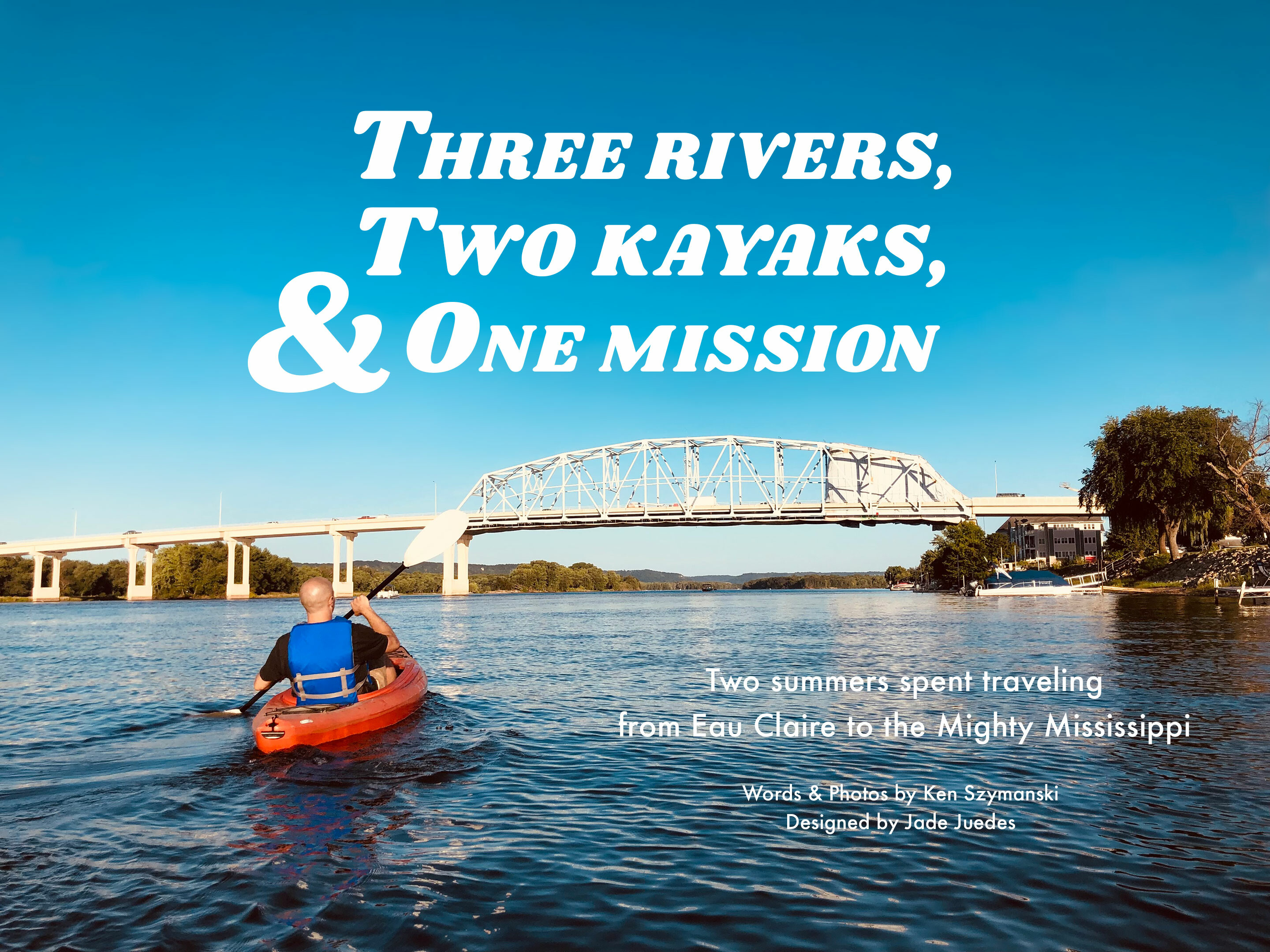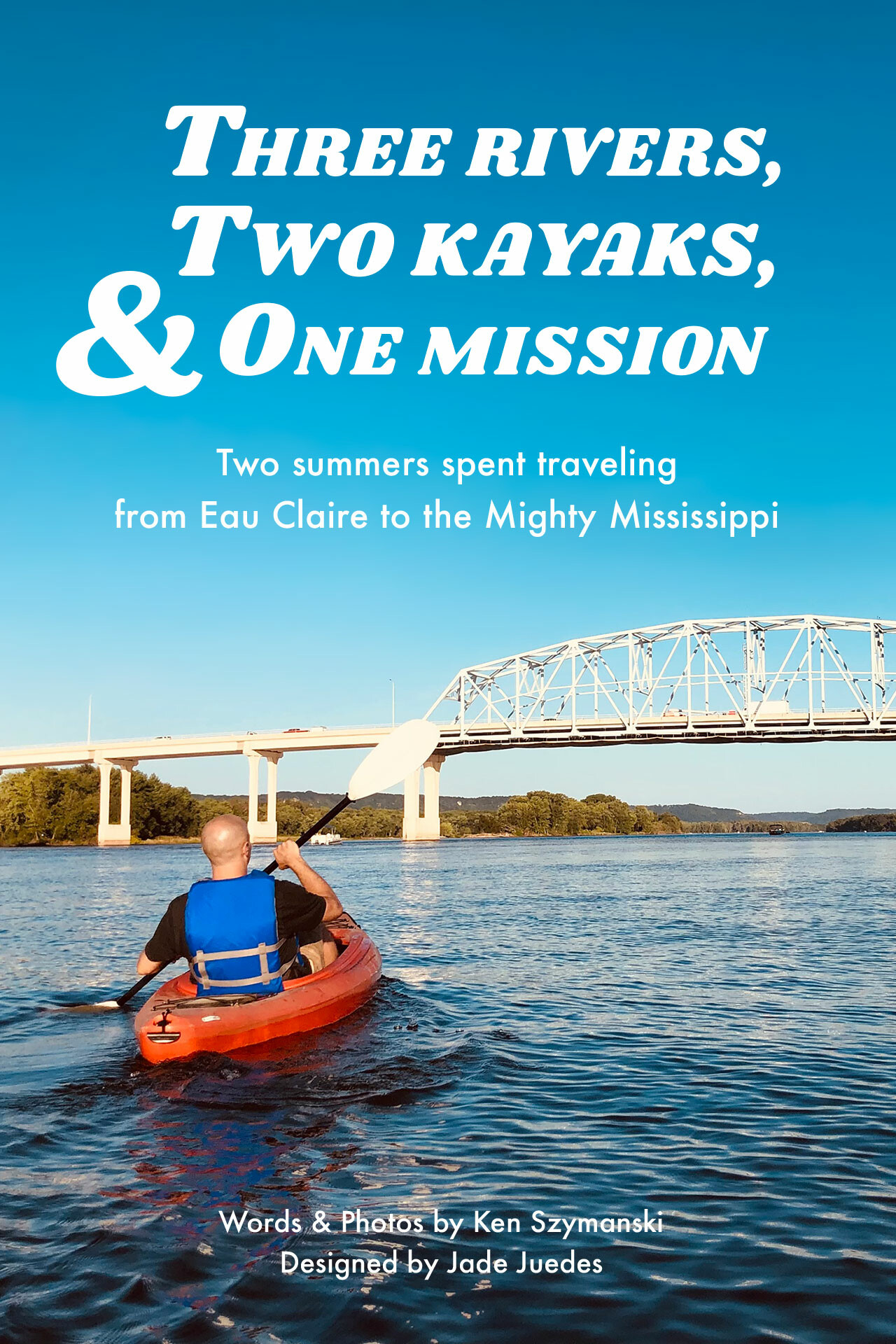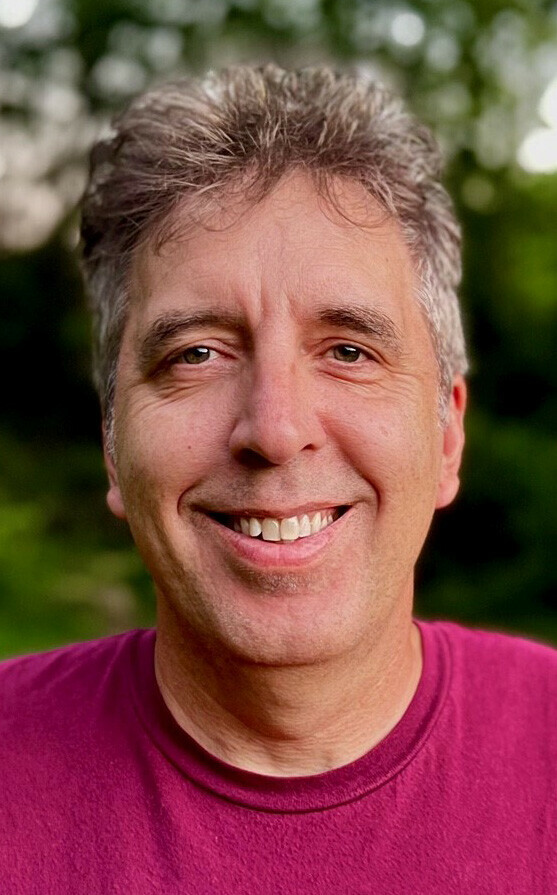The Mississippi River has been calling me since grade school when I saw a made-for-TV movie featuring Huck Finn and Tom Sawyer. The way they freely floated down the Mississippi made my Eau Claire life — unfairly saddled with homework and a curfew — feel restrictive. What I needed was a sturdy raft and a fast current. I pretended to be a rafter by spreading a blanket on the basement floor and adding empty boxes for supplies. My friends and I jumped overboard for weeks and months, swimming to imaginary islands and the adventures that awaited.

I was born and raised here in “Clear Water” Eau Claire, where the Eau Claire River meets the Chippewa River in the center of town. Bike trails border both rivers, and they offer incredible views. But over the years, sometimes the gears, the grind, and the asphalt still felt too tied to civilization. Huck Finn, after all, never needed a state-issued trail pass.
I always wanted a kayak — a lighter and more portable alternative to a canoe. I occasionally rented kayaks, which was better than shelling out hundreds of dollars for one and hundreds more for a trailer. But a few years ago, low-budget fate intervened. When my neighbors offered to sell their two kayaks in 2020 — and I realized I could fit them in the back of our minivan if I removed a seat — I took the plunge. Kayaking became a COVID hobby. With more traditional activities shut down, there was more breathing room for a leisurely paddle down the river.
One kayak was good for me, and the second could be for any number of Tom Sawyers I knew who needed a little change of scenery and, perhaps, a mental health break, too. The companionship, fresh air, and water could offer relief from the desperate news cycle that scrolled through the summers of 2020 and 2021.

River Prairie Park to Phoenix Park
My first expedition down the river started at River Prairie Park. My friend Matt and I floated 45 minutes to Phoenix Park. As we paddled down the river, Matt looked up at the clear blue sky and said, “I could do this all day.” It was like sitting on barstools talking, but healthier and with ever-changing scenery. We paddled under the Hastings Way bridge, the Boyd Park bridge, the S bridge, the Dewey Street bridge, the Farwell Street bridge, the Barstow Street bridge, and the Haymarket Plaza bridge, two old friends rehashing old stories and one-liners while adding some new ones into the mix.
A few days later, I told my friend B.J. about this excursion. Always up for a new adventure, he agreed to go without further questions. With such a short trip and commute, even a father of three like B.J. could fit this trip in and be home 90 minutes after walking out the door. He couldn’t get over the small bluffs, the towering trees, the cranes, deer, and the occasional bald eagle, just minutes out of Eau Claire. “This is incredible,” he said. “How did I not know about this?”
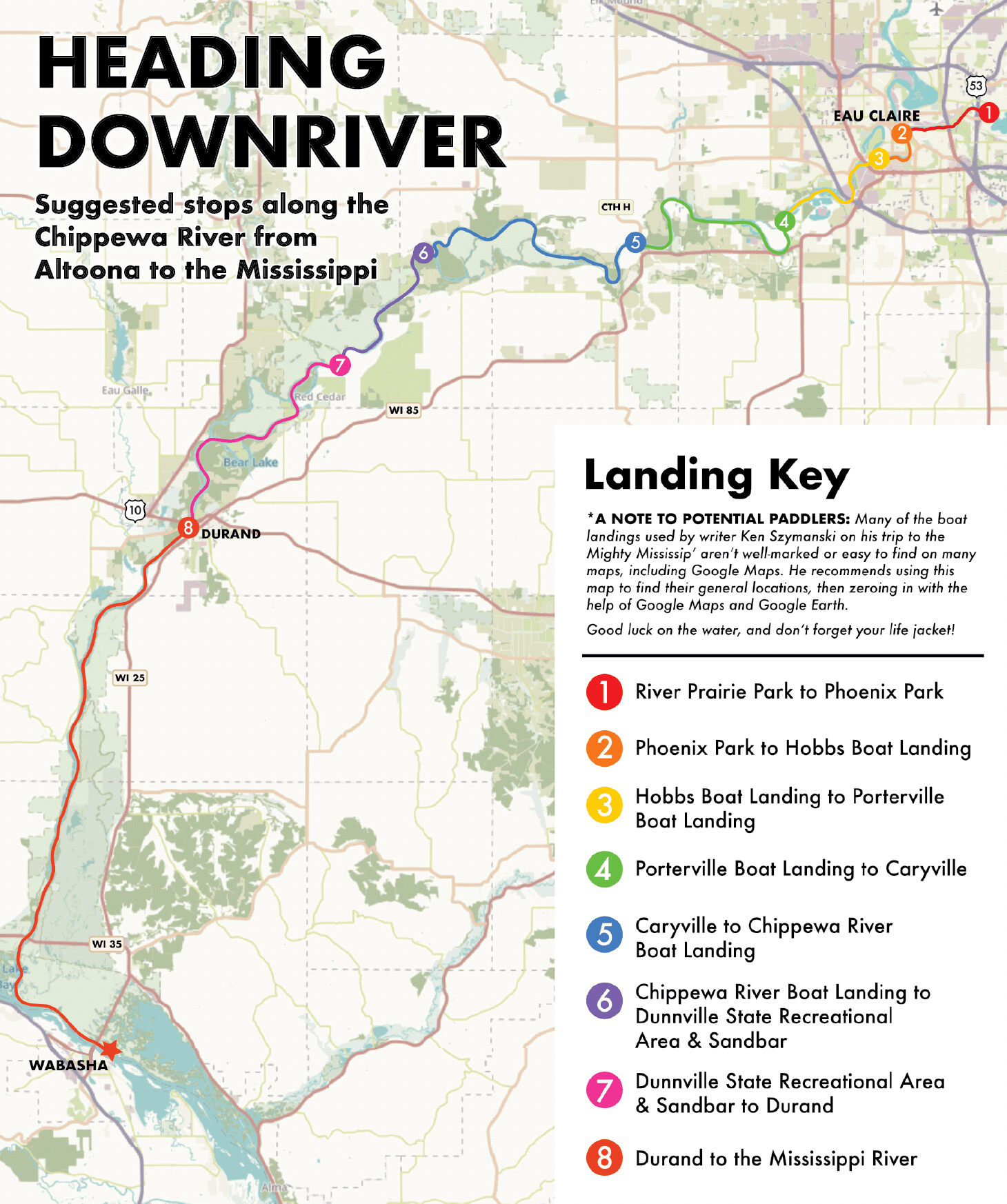
Despite the dicey rapids near Banbury Place, I loved taking people down that 45-minute stretch. Every companion experienced it a little differently. My brother Don could tell me every fishing hole along the way, what he caught, and what was biting on what bait. He knew the name of every tree, every plant, and every bird.
My friend Jeff was more of a novice, nervous about his lack of river experience. I assured him: “Even if we do nothing, we’ll still reach our destination.”
He was surprised at how easy it was. “You’re right,” he said. “This takes absolutely no talent — my kind of sport!”
One July evening, my wife Sarah and I left the kids at home for a quick sunset paddle. Unfortunately, in the one stretch that can be treacherous — the rapids near Banbury Place and the L.E. Phillips Memorial Public Library — her kayak turned sideways, flipped, and dumped her into the water. She stood up, unharmed but soaked.
The water wasn’t even waist-high, so I was able to walk against the current back to her. What we faced was an improbable quagmire. Sarah’s kayak was partially submerged, with rushing water continuously filling it and pinning it against a boulder. With all that water inside, it might as well have been filled with cement — and the rushing water trapping it in place was far stronger than both of us combined. No matter how much we pushed, pulled, and heaved, it would not budge.
This leisurely sunset ride was now turning into a problem. “We can’t just leave it here,” I said.
“We can’t stay here in the dark, either,” Sarah said.
Growing more desperate the darker it got, I reamed on the thing with more and more adrenaline. Finally, a half-hour after Sarah capsized, we worked it free. The paddle was long gone downstream, and there was no way to lift the full kayak to empty the water. So I gave Sarah my kayak seat and rode the bow, pulling the sunken boat alongside us. We finally floated through downtown at twilight, with me perched on the front like a sentinel, amusing the night fishermen along the banks as we arrived at Phoenix Park. We spotted our paddle waiting for us near the shore. Finally on solid ground, we dumped the water out of the kayak by the light of the moon.
It was a memorable way to spend our anniversary.

Phoenix Park to Hobbs Boat Landing
While I loved the Eau Claire River stretch, I also had it memorized. Though the Chippewa River is more expansive and slower, I wanted some new scenery. My friend Jim and I started at Phoenix Park, paddling to the Hobbs Boat Landing for a nice, slow two-hour ride through the center of town. We have kids the same age, and we talked about getting them out on the river someday. Jim had never kayaked before. He teaches at the university, and our trip took us under the Grand Avenue footbridge, the Lake Street bridge, the Water Street bridge, and right through campus from a vantage point he’d never seen. He’s walked and driven over the bridges, but it’s a different perspective under their shade. You see the swallows’ nests and float past the pillars, considering the work and engineering it took to build those structures.
While we floated, we talked about our kids: how to raise them, and how each one is a different puzzle to figure out. After two hours floating down the river, we hauled the boats into the van and returned to try to do just that. As we loaded up, Jim said, “I’d do this again, anytime.”

Hobbs Landing to Porterville Boat Landing
A couple weeks later, my friend Julian and I started where Jim and I left off at Hobbs Landing. This took us away from the city instead of into it. The Chippewa River is a slow and easy ride. There’s no drama or adrenaline rush. Instead, it lowers your blood pressure and gives you time to regroup. Julian and I are both writers, born just a few months apart, with plenty of common ground. We discussed getting back in shaped, his aging parents, and our writing goals. After a career in journalism, Julian’s still figuring out how to juggle the writing he wants to do for himself with the responsibilities of his day job and other community activism. There are only so many hours in a day. But on the river, time slowed as we talked and paddled under the Clairemont Avenue bridge, the Short Street bridge, and the Interstate 94 bridge. We solved nothing, but we let it go for a while and flowed with the current. After an hour, we saw the ski jump in Shawtown. That was our marker to find the Porterville Boat Landing and head back to figure out our lives in real-time. “Thanks,” Julian said. “I needed this.”
But looking downriver, I wondered: What if we just kept going?
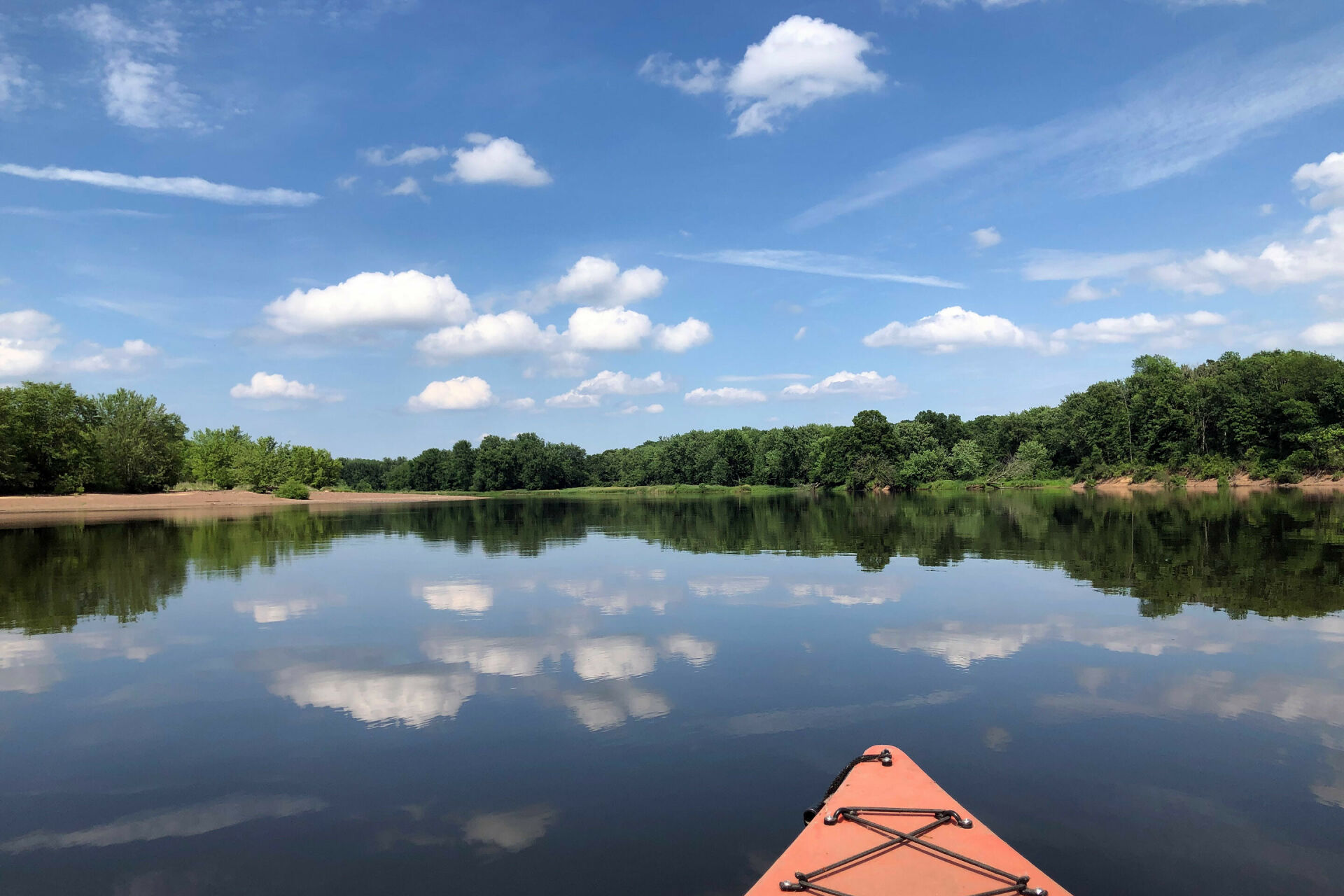
Porterville to Caryville
The next stretch — from Porterville to the Holte’s Landing near Caryville — would take about three hours. Add in the shuttling time, and it was more commitment than I wanted. But Matt and I decided that we needed more time on the river, and we needed to see the next segment.
In this more secluded section, the scenery kept getting better and better. We enjoyed the beaches, the flat lands, the hills, and the wide-open sky — both the sunny and cloud-covered versions. Every so often, a sturgeon jumped out of the water with a startling splash. We also watched eagles dive-bomb the river for food — coming up empty a few times before scoring.
Matt and I discussed our jobs as middle school teachers, which we’ve been at for a combined half-century. We know the same spectrum of frustrations and triumphs, so we can speak in conversational shorthand — no need to overexplain everything. Our shop talk is always joke-centered rather than school-policy-centered. That’s why we can talk shop even in the summer. Comedy is comedy. If we’re laughing, we’re winning.
At some point on this stretch, we went from relaxation, laughter, and wonder … to wondering if we would make it. The setting sun was beautiful, but the ensuing darkness would make it difficult to spot our landing. We paddled harder, racing the setting sun. What if we missed the landing, and the current sent us onward? Our next stop was in three more hours … which would be midnight, without a vehicle. Keeping a close eye on the shore, we saw the silhouette of the County Road H Bridge and took our exit with barely enough light to see.
We loaded the kayaks, already thinking about the next possible leg of the journey. Over the next several days, we exchanged screenshots of maps and estimated times. This was too good not to press our luck.
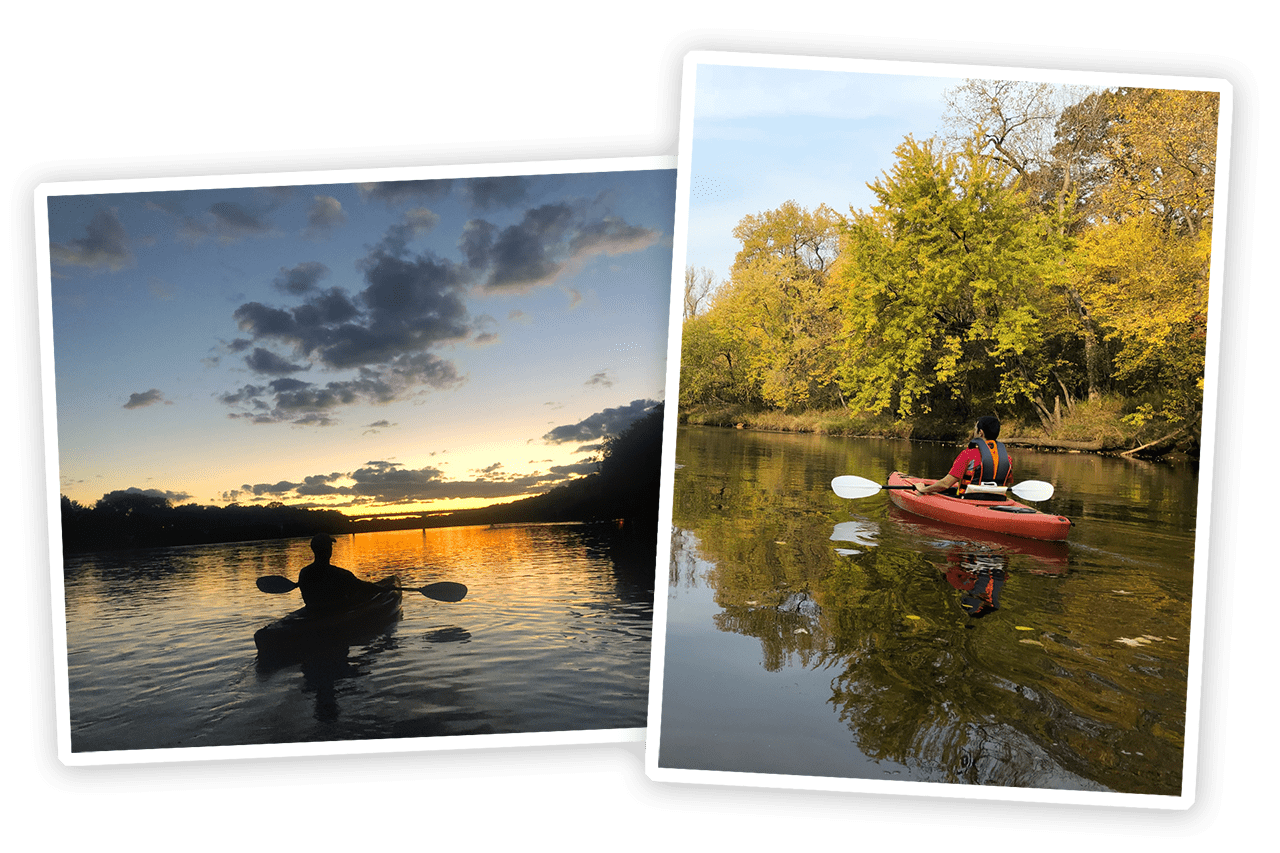
Left: Matt is silhouetted against the sunset on the Chippewa River.
Right: B.J. travels along the Eau Claire River upstream from Banbury Place.
Caryville to the Chippewa River Boat Landing and Chippewa River Boat Landing to Dunnville State Recreational Area & Sandbar
With so many curves in the river, along with the varying water levels and current speeds, our time estimates were more like guesses. Matt and I slid the kayaks in the water by the County Road H bridge, hoping for the best. I was glad to get him out of the house again. Like so many people, he was going through tough times in his personal life. He didn’t want to talk about it, and we didn’t have to. At least we were doing something, taking his mind off things. One of the best options on the river is to not talk about things, to leave them behind. And we’ve been friends long enough to know that riding in silence for a while is also a viable option. On the river, the scenery can do the talking. I didn’t know how to help him, but it felt like these trips were the best I could do.
Though close to home, the hilly geography was a good distraction, and these trips gave us a goal. We became obsessed with Google Maps and the possibilities of how far we could go in installments. Maybe the Mississippi River could eventually be within reach.
These two sections took us three hours apiece, and both were summer highlights. Echoing B.J.’s earlier comments, I wondered, How did I not know about this?
I took plenty of pictures. “Send me one of those in the middle of winter,” Matt said.
Eventually, I did — like throwing out a floatation device.
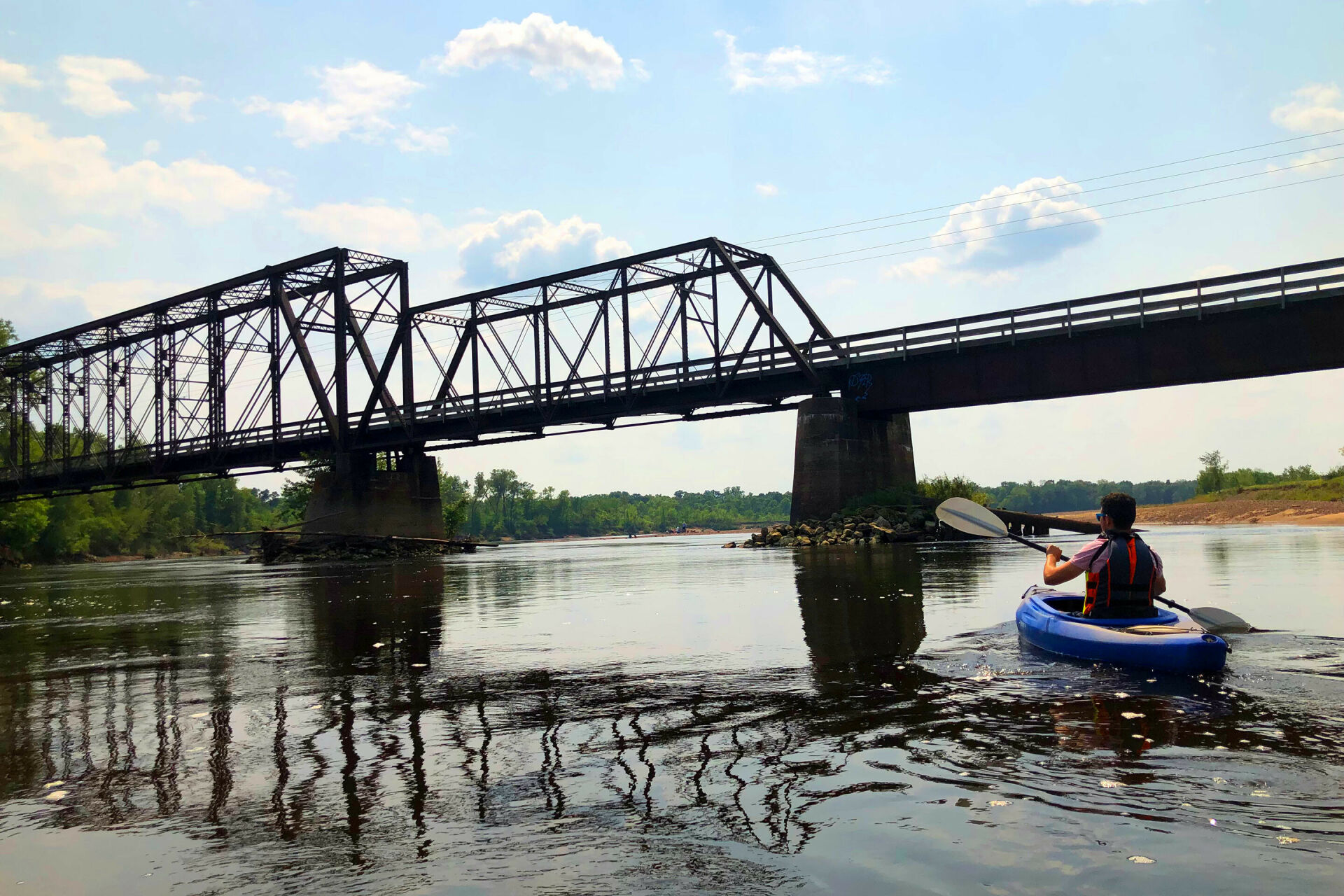
Dunnville State Recreational Area & Sandbar to Durand
B.J. was back in the saddle for this next segment — though making time for it wasn’t easy. He was juggling several projects, organizations, meetings, while also writing books, working as an English professor, and being a married father of three. He can’t sit still. Neither can I. We can only sit still if we’re in these kayaks, in motion — brainstorming ways to make life even busier with new podcasts, readings, retreats, and collaborations. Call it productive relaxation. We also discussed the dangers of overextending ourselves. We both agreed that while we didn’t have time for this, we did have time for this, too.
And on this stretch, we had three hours of inspiring new scenery. Around the next bend could be a beach or a farm field. We’d find out when we got there. I felt like I was vacationing in another state, but I was just a half-hour car ride from home.
Once, under a railroad bridge, we heard a train horn sounding, which was perfect timing. Four engines pulled boxcars and tankers high above us for five long minutes. A train in another setting would be forgettable, even a nuisance. But looking at this train suspended hundreds of feet above the river, above us, with blue sky and hand-painted clouds in the background, it was worthy of a sepia-toned Americana postcard. Everything is better on the river. “I bet we both write an essay about this by noon today,” B.J. joked.
Durand to the Mississippi River
At this point, we were only a 25-minute drive down the highway from the Mississippi. One more power stretch, and I could carry out my childhood goal of making it to the Mighty Mississippi River. How long would it take by river? I called the City of Durand. They didn’t know. No one on the Internet knew, either. I sensed that not many people took this trip without a motor.
Was it necessary to turn a casual hobby into a geographical conquest? No, but it did make it more fun. I estimated four to six hours for that stretch.
Matt and I set out on the kayaks in the morning from Durand and settled in for the long haul. It was an exercise in patience, made easy by the novelty of the scenery. Each section of the river was different. Would it be flatland or hills? Thick woods or sandy beaches? Would the water be deep or shallow? Curved or straight? When faced with a fork in the river, we took the wider one. We paddled and paddled. We took some stretch breaks on the beaches and swimming breaks to cool off. By the time we emptied the cooler of food, we heard jet skis and boat motors, confirming that we were closing in on the Mississippi River superhighway.
“We must be getting close,” we said. A half an hour later, we said it again.
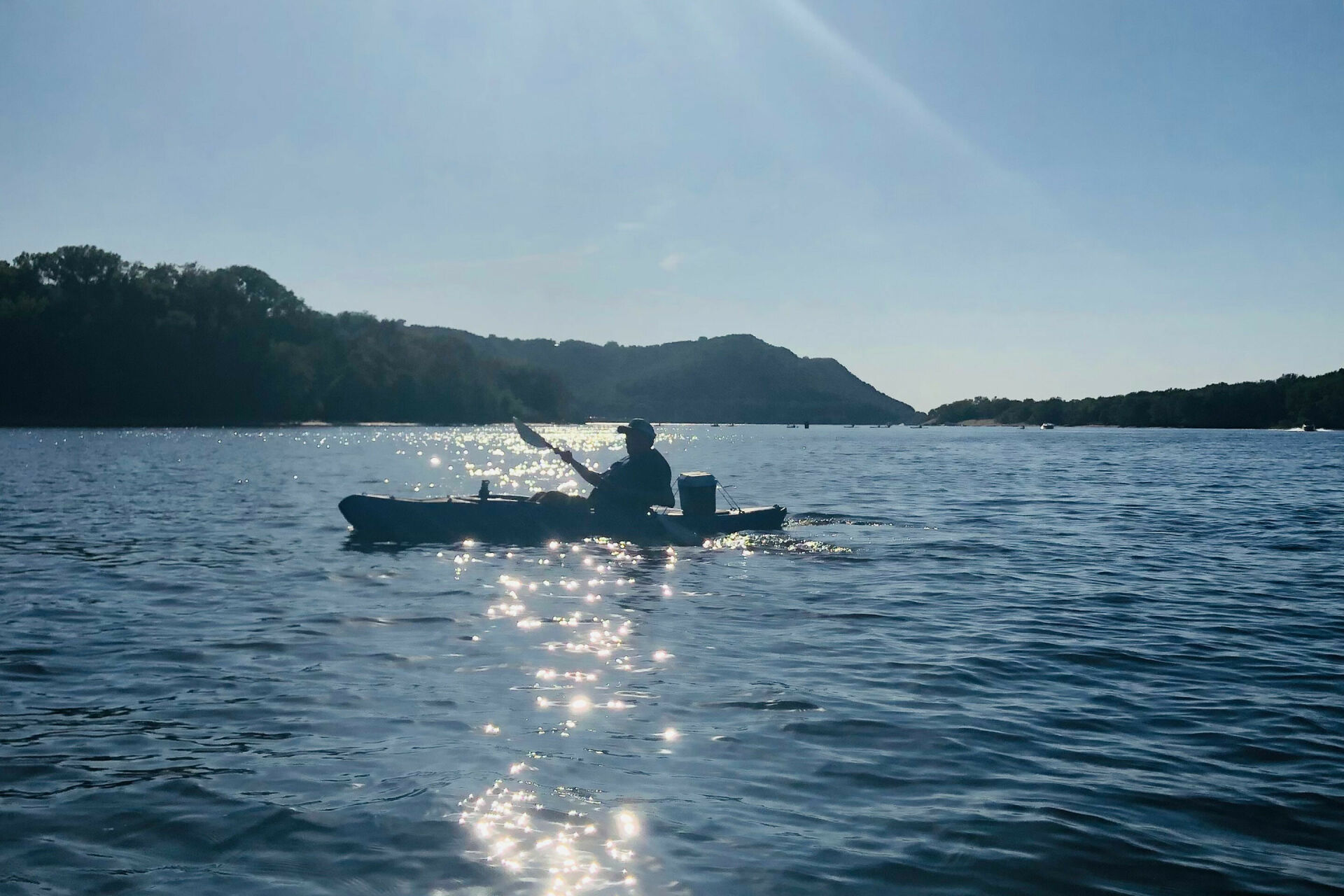
Finally, six hours after setting off from Durand, the Chippewa River ushered us into the Mississippi. Just like that, my childhood vision became a reality — though it was a lot noisier than expected. Air boats — with their aircraft engines — repeatedly squashed our conversation. The owners wore ear protection while the rest of us had to deal with the roar. We rode the giant wakes of yachts, trying to stay clear and hoping they could see us. Some yachts carried 30 people, stereos cranked, with flapping American flags larger than our kayaks. They looked at us, amused, as if we were pedaling tricycles down the interstate. The scenery was once again doing the talking, but in a whole new way. People parked and partied on every sand shore — living Midwestern versions of the Jimmy Buffet lifestyle. We probably should’ve done this portion on a weekday. Still, we took celebratory pictures amongst the chaos.
Unlike the easy-going Chippewa River, paddling the Mississippi required significant effort. Out in the wide open, the wind and choppy waters worked against us. We often felt like insignificant specks on the verge of getting smashed by a houseboat.
We worked for two more hours to the National Eagle Center in Wabasha. I thought that bald eagles would fill the skies. Back on the Chippewa River, eagle sightings outnumbered people sightings, but here, we didn’t spot a single one.

Finally, we reached our parking spot. By then, neither of us cared if we ever kayaked the Mississippi again. Eight hours on the rivers — with temperatures peaking in the 90s — had us worn out. But over two summers, we had achieved our goal and pieced together the whole trip.
While I’d accomplished my mission of arriving at the Mississippi, the miles of the river leading up to it were far better. The whole process, actually, was a long, memorable tributary: the texting, calling, planning, and tying down the kayaks in anticipation. The conversations through car windows on the side of the road after making a wrong turn. And finally, the easy, calm, secluded flow of the Chippewa River.
On these trips, I was the only constant. Not only did the scenery change but so did the rotating Tom Sawyer in the other kayak. For each person in that seat, it was therapeutic. At some point — amid the beautiful landscape, the solitude, the soaring bald eagles, the granola bars, and a Gatorade cracked open under a wide-open Wisconsin sky — something changed, if only for an hour or three.

Over time, you feel yourself zooming out, absorbed in the beautiful topography, and your problems feel smaller, too. Hopefully, the same happens for your traveling companions. In retrospect, Matt refers to those trips as life-altering days during a dark time. The timeless, reliable current carried us on a journey we couldn’t have completed alone.
There’s a promise around each bend in the Chippewa River, and — if we had the time — those waters could carry us along Huck Finn’s old route all the way to the Gulf of Mexico. But the Chippewa River is good enough — with 20 hours of slow-but-steady current between Phoenix Park and the Mississippi. There are no shortcuts, no drive-throughs, and no fast-forward. Slowing down, you can see the big sky’s reflection in that river, and if you travel it long enough, finally, you can find your own.
Ken Szymanski is an author, educator, and currently the City of Eau Claire’s Writer-in-Residence. You can learn more about his work at kenszymanski.com.
